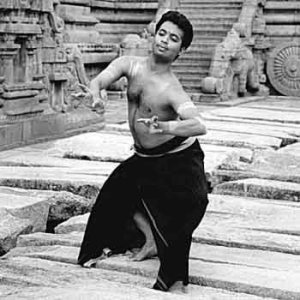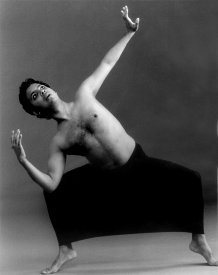
|
 |

|
 |
Voice of the diaspora is very important: Hari Krishnan - Lalitha Venkat, Chennai e-mail: lalvenkat@yahoo.com Photo: Cylla von Tiedemann November 27, 2006  Toronto-based Hari Krishnan is a dancer, choreographer, teacher and dance scholar. He works in a contemporary vein abstracting and drawing elements from a variety of sources and sensibilities. Hari Krishnan's creative output is holistic, combining the allied arts of Bharatanatyam dance, music, theatre and theory with contemporary, urban, post-modern culture. Trained by hereditary dance masters including K P Kittappa Pillai and R Muttukkannammal, Krishnan received his M.A. degree in Dance from York University. Artistic director of Toronto-based inDANCE, Krishnan is also a World Dance Artist in Residence at the Department of Dance in Wesleyan University (Connecticut, USA). His experimental and vintage choreographies continue to be performed at international venues. For close to a decade, Krishnan has been involved with the documentation, translation and analysis of the last vestiges of hereditary systems of dance in South India. His research brings together several interpretive and theoretical approaches, as it integrates the disciplines of performance studies, anthropology, history, and gender studies. Krishnan is currently working with Canadian dance legend Margie Gillis, who is creating a solo for him that will premiere in 2007. Hari Krishnan and inDANCE present an evening of contemporary dance on Dec 3, 2006 for The Other Festival at Museum Theatre (Chennai), 7pm. Natya Stem Dance Kampni, Arangham Trust and Alliance Francaise present inDANCE on Dec 5, 2006 at Alliance Francaise (Bangalore), 7pm. Hari Krishnan talks to narthaki about his approach to traditional and contemporary dance styles. Trained in classical Bharatanatyam, what motivated you to venture into contemporary work? Are there any role models that inspired you to explore new forms? If we approach this idea from a critical-historical perspective, the reconstruction of Bharatanatyam as a neo-classical dance form is already a clear break from traditional devadasi dance. I see my explorations into contemporary Bharatanatyam as a natural extension of this modernity. In terms of role models, my devadasi teachers and nattuvanar masters continue to inspire and fuel my artistic work. The eroticism, sensuality, and fluid negotiation of gender roles and sexuality in devadasi dance is very beautiful for me. Unfortunately this attitude, which I feel is in some ways compatible with our modernity, was lost in the revival of Bharatanatyam after the 1930s. It is this vision that I embrace both in my presentations of devadasi repertoire as well as my experimental work. Dancer Keshava in Switzerland says people there want to learn Bollywood dancing and he's even presenting Bollywood dance programs. Jhelum Paranjape's Odissi Bollywood Ishtyle is very popular. How popular is Bollywood dance in Canada and US? Bollywood dance is clearly an extremely popular form. I feel this is due to the fact that popular Indian cinema is so deeply rooted in ideas about Indian nationalism, negotiating "traditional Indian culture," gender roles, etc. that have a kind of nostalgic appeal for Indians living abroad. These issues are also important in terms of the construction of hyphenated (i.e Indian-American, Indo-Canadian) cultural and social identities. In the Indian diaspora, Bollywood dance continues to be THE entry point and the primary cultural marker of Indians living abroad.  On one hand you are doing research on the devadasis. On the other, you are into contemporary work and your latest is Bollywood Hopscotch. Are you also inspired by the energy of Bollywood style of dancing? My piece Bollywood Hopscotch is not about replicating Bollywood dancing. I am not interested in that. The piece questions the nature of modern Bharatanatyam and its relationship to popular cinema. I am always interested in what happens when elite art meets popular art - this has been happening in Bharatanatyam since the 1940s, and today, I think that the boundaries between popular art and elite art have completely disappeared. My choreography Bollywood Hopscotch is a satire on the state of Indian classical dance today, and its very hybrid permutations. This piece is my personal response to concepts of melodrama and hyper-exaggeration and athleticism that characterize modern Bharatanatyam. This is why in Bollywood Hopscotch the Bharatanatyam abstract rhythmic dance sections meander organically into the various Bollywood vignettes. The piece dramatizes the clash and dissonance between two colliding aesthetic frameworks You perform mostly outside India. What do you think is the status of Indian contemporary dance and classical dance in the diaspora? What do you think of the contemporary dance scene in India as compared to outside India - by diaspora dancers? Once again, I strongly believe in dancers re-reading their histories and re-negotiating their value systems on what words like "traditional" and "contemporaneity" mean. All the classical forms in India are new forms, reconstructed and reinvented after 1930s based on a variety of aesthetic, political and social agendas. So for me, contemporary Indian dance is a natural (and somewhat inevitable) evolution and extension of these new forms. With massive amount of Indian dance being taught, performed and consumed outside of India, I feel the voice of the diaspora is very important. The new global pathways in which Bharatanatyam has been circulating over the past 10-15 years can be divided into three major movements: (1) Classical dancers who strive to re-create India / Chennai wherever they are in terms of presentation, art production and audience development; (2) Classical dancers who somehow feel motivated to create contemporary work because of what their peers are doing or feel contemporary work creations are the only way to stand out among the vast pool of competing classical dancers. The contemporary creations coming out of this group very often use classical dance as a safety net; (3) Contemporary artists who only create/perform modern work and reject classical dance, very often dismissing it as cosmetic, redundant or artificial. For me, dance artists should constantly take challenges and risks, always reinventing themselves and progressing in their own artist development. Creating contemporary work or classical work has its own set of problems and difficulties. Artists should allow themselves to grow organically and not be compelled to churn out work for the sake of creating something "that looks different" or lacks meaning. How easy or difficult is to get funding to tour with your ensemble? Internationally, funding continues to be a tricky situation. Artists constantly have to justify their medium, their artistic processes and their final outcome. With so many dance artists from various cultural representations and various genres, funding has become extremely competitive. The wonderful thing about Canada is that funding is based on excellence and merit and I take great pride that mediocrity in dance is carefully weeded out. I think that international tours are very important for the growth of any dance company. Contact Hari Krishnan Artistic Director, inDANCE 21 River Street, Studio 4 Toronto, Ontario M5A 3P1, Canada Tel: (416) 304-1690 Fax: (416) 304-0228 Email: indance@sympatico.ca / indance@gmail.com indance.ca |